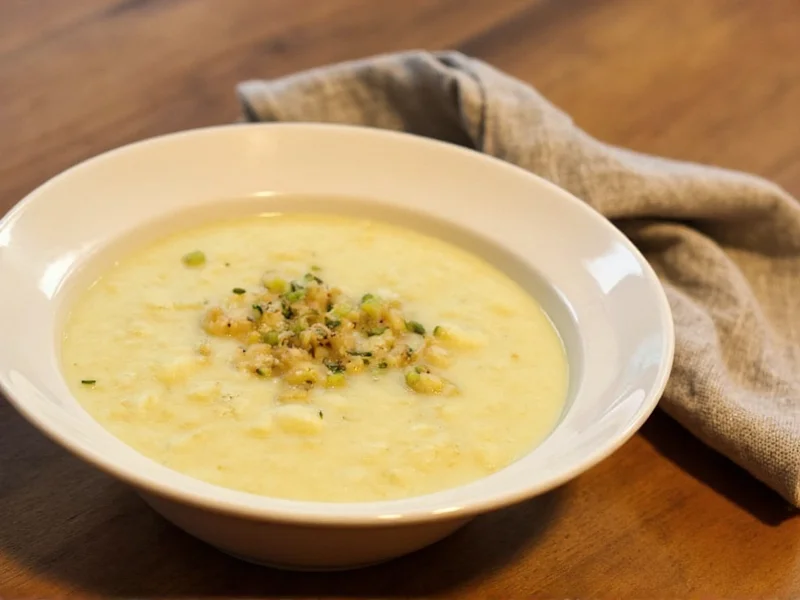Transforming mashed potatoes into restaurant-quality soup is one of the most practical kitchen hacks for home cooks. This approach leverages the already-cooked potatoes' perfect texture and starch content, eliminating the lengthy boiling process required when starting with raw potatoes. Whether you're repurposing Thanksgiving leftovers or planning an efficient weeknight dinner, this method delivers consistent results with minimal effort.
Why Mashed Potatoes Make Superior Soup Base
The secret to exceptional potato soup from mashed potatoes lies in the pre-gelatinized starch. When potatoes are boiled and mashed, their starch granules absorb water and swell, creating an ideal foundation for creamy soups without requiring roux or additional thickeners. This scientific advantage means:
- Faster preparation time compared to traditional methods
- Naturally smooth texture without lumps
- Better flavor integration as seasonings absorb directly into the potato matrix
- Reduced risk of overcooking that causes grainy texture
Perfect Proportions for Potato Soup Success
Getting the liquid-to-potato ratio correct is crucial. Too much liquid creates thin, watery soup; too little results in an unspreadable paste. This tested formula works for any batch size:
| Mashed Potatoes | Broth | Milk or Cream | Total Servings |
|---|---|---|---|
| 2 cups | 3 cups | 1 cup | 4 servings |
| 4 cups | 6 cups | 2 cups | 8 servings |
| 6 cups | 9 cups | 3 cups | 12 servings |
Step-by-Step Recipe for Creamy Potato Soup
Follow these professional techniques for restaurant-quality results every time:
- Prepare aromatics: Sauté 1 diced onion and 2 minced garlic cloves in 2 tablespoons butter until translucent (5-7 minutes)
- Build flavor foundation: Add 1 diced celery stalk and 1 diced carrot, cooking until slightly softened
- Incorporate potatoes: Gradually whisk in mashed potatoes, ensuring no lumps form
- Add liquids: Slowly pour in broth while stirring, then add milk/cream
- Season properly: Include 1 teaspoon each of dried thyme and smoked paprika, plus salt and pepper to taste
- Simmer gently: Cook on low heat for 15-20 minutes, stirring occasionally (do not boil)
- Final texture adjustment: Use an immersion blender for 10-15 seconds if desired creamier texture
Proven Variations for Every Palate
Customize your potato soup using these chef-tested variations that maintain perfect texture:
Creamy Bacon & Cheddar
Add 6 ounces cooked, crumbled bacon and 1 cup shredded sharp cheddar during final simmer. Garnish with extra cheese and chives.
Loaded Baked Potato Style
Stir in 1/2 cup sour cream with the milk, then top servings with diced ham, green onions, and a dollop of additional sour cream.
Dairy-Free Option
Replace milk with unsweetened almond milk and use olive oil instead of butter. Add 1/4 cup nutritional yeast for cheesy flavor.
Avoiding Common Pitfalls
Even experienced cooks encounter these issues when making potato soup from mashed potatoes. Here's how to prevent them:
- Grainy texture: Caused by overmixing or boiling. Always simmer gently and avoid vigorous blending
- Watery consistency: Results from incorrect ratios. Measure liquids precisely and remember mashed potatoes contain moisture
- Bland flavor: Underseasoned potatoes need extra salt. Season in layers: broth, during cooking, and final adjustment
- Separation: Occurs when dairy is added to high heat. Always temper dairy by mixing with small amount of hot soup first
Storage and Reheating Guidelines
Proper storage maintains texture and flavor for future meals:
- Cool completely before refrigerating (within 2 hours of cooking)
- Store in airtight container for up to 4 days
- Freeze for up to 3 months (thaw overnight in refrigerator)
- Reheat gently on stove over medium-low heat, adding small amounts of broth if thickened
- Never microwave without stirring frequently to prevent uneven heating
Frequently Asked Questions
Can I use instant mashed potatoes for soup?
Yes, instant mashed potatoes work well for soup. Use 1 cup instant flakes with 3 cups broth and 1 cup milk. Whisk continuously while adding liquid to prevent lumps. You may need slightly less liquid than with homemade mashed potatoes since instant varieties contain stabilizers.
How do I fix potato soup that's too thin?
For thin potato soup, create a slurry with 2 tablespoons cornstarch mixed with 1/4 cup cold broth. Whisk into simmering soup and cook for 2-3 minutes until thickened. Alternatively, blend 1 cup of the soup and return it to the pot for instant thickening without altering flavor.
What vegetables complement potato soup best?
Leeks, celery, and carrots enhance potato soup's flavor profile without overpowering it. For heartier versions, add diced ham, cooked broccoli, or roasted garlic. Avoid watery vegetables like zucchini which can make the soup thin. Sauté vegetables with the aromatics for best flavor integration.
Can I make this soup gluten-free?
Absolutely. This mashed potato soup recipe is naturally gluten-free when using gluten-free broth. Verify all packaged ingredients (like broth and instant potatoes) carry gluten-free certification if needed. The potatoes themselves provide sufficient thickening without requiring flour-based roux.
How do I prevent potato soup from turning gray?
Gray discoloration occurs when potatoes react with acidic ingredients. To prevent this, add acidic components like lemon juice or tomatoes after the soup has finished cooking and has cooled slightly. Store soup in non-reactive containers and consume within 3-4 days for best color retention.











 浙公网安备
33010002000092号
浙公网安备
33010002000092号 浙B2-20120091-4
浙B2-20120091-4